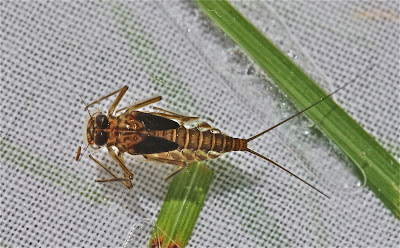Monday, September 3, 2012
Epeorus deceptivus: A "Western" Style Flatheaded Mayfly, Genus Epeorus
This is a flatheaded mayfly that I found in Montana, in Petty Creek, on August 12, and this is a photo that I almost didn't take. Surely, I thought, this nymph is Epeorus pleuralis, a species we commonly see in Virigina in the winter and spring. Here are two photos of E. pleuralis nymphs that I took in 2011.
Unfortunately, when I looked at "Fly Fishing Entomology: Pacific Northwest Mayflies," I discovered that Epeorus pleuralis does not occur in the West! So I'm glad I did take some photos. Here's another.
Our Montana nymph is Epeorus deceptivus ("Light Blue Quill") which is described in "Pacific Northwest Mayflies" in the following way: "Abdomen light to dark chocolate brown; thorax medium olive brown; 1st gills extend forward under the thorax, but don't curve inward and overlap; blunt femoral flange; 2 tails. "
The colors are right, and yes, there are two tails. What about the gills and the femoral flange?
The 1st gills do indeed "extend forward" under the thorax, but they do not overlap. The femoral flange does appear to be blunt.
How does this differ from the species we see all the time in local streams, Epeorus pleuralis? For one thing, the first gills on E. pleuralis do not extend forward under the thorax; neither the first pair of gills nor the last pair of gills overlaps. Have a look.
The last pair of gills on E. deceptivus nymphs, by the way, is close to overlapping; the tips may well have overlapped when the nymph was alive.
Actually, the gills on E. deceptivus look a lot more like the gills on our Eastern genus Rhithrogena flatheaded mayfly than those on E. pleuralis.
What about the femoral flange? The femoral flanges on E. pleuralis nymphs appear to me to be pointed, not blunt. I hope you can see that in the following picture -- be sure to click on it to enlarge it.
These points seem even more pronounced on E. vitreus nymphs, E. pleuralis' summer cousin. (Again, click on the photo to enlarge it.)
________________
So there you have it. E. deceptivus looks a lot like E. pleuralis, but the morphology isn't the same. Appearances can be "deceiving" (pardon the pun!), and we have to use Western keys when dealing with Western nymphs and larvae.
_______________________
Subscribe to:
Post Comments (Atom)












No comments:
Post a Comment